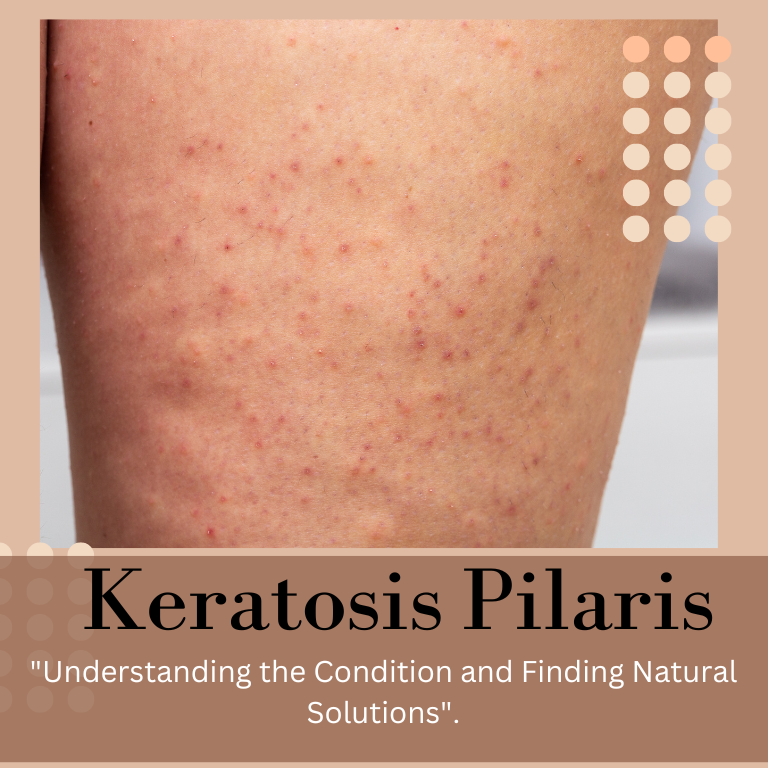
Keratosis Pilaris – “Understanding the Condition and Finding Natural Solutions”.
Keratosis Pilaris is a common skin condition that causes small, rough bumps to form on the skin, typically on the arms, thighs, cheeks, and buttocks. The bumps are usually skin-colored or slightly red and may feel rough or dry to the touch, like sandpaper.
Keratosis Pilaris is a very common skin condition, affecting 40-50% of adults and up to 80% of adolescents. It can occur in people of all ages but is more commonly seen in children and adolescents.

Keratosis Pilaris is sometimes called “chicken skin” because of its appearance.
The condition occurs when there is a buildup of keratin, a protein that helps protect the skin, in the hair follicles. The excess keratin causes the hair follicles to become plugged, leading to the formation of bumps. Keratosis pilaris is typically harmless and doesn’t require medical treatment, but it can be unpleasant.
What happens in keratosis Pilaris
In keratosis Pilaris, excess keratin builds up within the hair follicles, causing the formation of tiny, rough bumps on the skin’s surface.
The keratin forms a scaly plug that blocks the hair follicle’s opening, resulting in the bumps’ formation.
The condition usually affects the arms, thighs, cheeks, and buttocks. Still, it can occur in other areas of the body as well. Keratosis Pilaris is generally considered harmless, but it can be aesthetically unpleasant for some people. It is not contagious, and it is not associated with any serious health risks.

Keratin buildup occurs in keratosis pilaris due to a process called Hyperkeratinization.
Hyperkeratinization is the excessive production and buildup of keratin, a tough, fibrous protein that helps protect the skin. In keratosis pilaris, the hair follicles become plugged with excess keratin, forming small, rough bumps on the skin’s surface. The exact cause of Hyperkeratinization in keratosis pilaris is not entirely understood, but it is believed to be related to genetics, dry skin, or other skin conditions such as eczema.
The condition can worsen in dry climates or during the winter when the air is dry.
Several factors may contribute to the development of keratosis Pilaris, including:
- Genetics: Keratosis Pilaris often runs in families, and certain genetic factors may increase the risk of developing the condition.
- Dry skin: People with dry skin are more likely to develop keratosis Pilaris, as dry skin can lead to the buildup of dead skin cells and excess keratin.
- Other skin conditions: Keratosis Pilaris is more common in people with other skin conditions, such as eczema.
- Hormonal changes: Keratosis Pilaris may worsen during puberty, pregnancy, or menopause when hormonal changes can affect the skin.
- Certain health conditions: In rare cases, keratosis Pilaris may be associated with certain health conditions, such as vitamin A deficiency or an underactive thyroid gland. Keratosis Pilaris has been associated with vitamin A deficiency, as vitamin A is important for healthy skin and helps regulate the production and shedding of skin cells. However, it is important to note that not all cases of keratosis Pilaris are caused by a vitamin A deficiency, and the exact cause of the condition is not fully understood
- Environmental factors: Exposure to certain environmental factors, such as dry air, can worsen the symptoms of keratosis Pilaris.
- Some evidence suggests that Stress may play a role in the development or worsening of keratosis pilaris. Stress can affect the immune system, impacting the skin’s ability to maintain moisture and properly exfoliate dead skin cells. This can lead to the buildup of keratin in the hair follicles and the development of keratosis Pilaris. Additionally, stress can exacerbate other underlying factors that contribute to the condition, such as dry skin or hormonal changes. However, more research is needed to understand the relationship between stress and keratosis Pilaris.
- Obesity: Obesity has been associated with an increased risk of developing keratosis Pilaris. This may be because excess body weight can lead to increased levels of insulin and inflammation in the body, which can contribute to the development of skin conditions like keratosis Pilaris. Additionally, obese individuals may be more likely to have other health conditions that increase their risk of developing keratosis Pilaris, such as diabetes or metabolic syndrome.
While no conventional medications are specifically approved for treating keratosis Pilaris, some topical treatments are often used off-label to manage the condition. However, these treatments may come with potential side effects. For example, creams or lotions containing alpha-hydroxy acids or retinoids may cause skin irritation, redness, or peeling. Additionally, some treatments may exacerbate the dryness of the skin, which can worsen the symptoms of keratosis Pilaris.
Specific topical treatments, such as retinoids, can also increase the skin’s sensitivity to the sun, increasing the risk of sunburn or skin damage. Individuals may sometimes experience allergic reactions to the ingredients in topical treatments, resulting in itching, redness, or swelling.
It is essential to consult with a healthcare provider before using any topical treatment for keratosis Pilaris to understand the potential risks and benefits. It is also crucial to follow the instructions carefully and avoid overuse or misuse of these products to prevent increased side effects.
Natural treatments
Natural treatments for keratosis Pilaris may include:
- Exfoliation: Gentle exfoliation with a loofah or exfoliating brush can help remove dead skin cells and reduce the appearance of keratosis Pilaris. Avoid using harsh scrubs or overly aggressive exfoliation techniques, as this can cause irritation.
- Moisturizing: Keeping the skin well-moisturized can help reduce dryness and prevent the buildup of dead skin cells that can contribute to keratosis pilaris. Choose a non-irritating, fragrance-free moisturizer and apply it regularly.
- Coconut oil: Coconut oil contains lauric acid, which has been shown to have antimicrobial and anti-inflammatory properties. Applying coconut oil to the affected area may help reduce inflammation and soften the skin.
- Omega-3 fatty acids: Omega-3 fatty acids are anti-inflammatory and may help reduce inflammation associated with keratosis pilaris. Eating foods rich in omega-3s, such as fatty fish or taking an omega-3 supplement, may be beneficial.
- Vitamin A: Vitamin A is essential for healthy skin and may help reduce the appearance of keratosis pilaris. Eating foods rich in vitamin A, such as sweet potatoes or carrots, or taking a vitamin A supplement may be helpful.
Herbs

There is limited scientific research on the use of herbs to treat keratosis pilaris, and there is no definitive evidence that any specific herb can effectively treat this condition. However, some herbs that may have anti-inflammatory or moisturizing properties and could potentially help alleviate symptoms of keratosis pilaris include:
- Aloe vera: Aloe vera is known for its soothing and moisturizing properties. Topically applying to the affected area may help reduce inflammation associated with keratosis pilaris.
- Chamomile: Chamomile has anti-inflammatory and calming properties and may help reduce redness and irritation associated with keratosis pilaris. Chamomile can be applied topically as an oil, cream, or compress.
- Calendula: Calendula is known for its anti-inflammatory and wound-healing properties. It may help reduce inflammation associated with keratosis pilaris. Calendula can be applied topically as an oil or cream.
- Witch hazel: Witch hazel has astringent and anti-inflammatory properties and may help reduce inflammation and redness associated with keratosis pilaris. It can be applied topically as an oil or toner.
It is important to note that while herbs may be a natural and safe alternative to conventional treatments, they may also cause allergic reactions or other side effects. It is essential to talk to a healthcare provider before using any herbal treatment for keratosis pilaris.
Homeopathy

Homeopathy is a holistic approach to medicine that utilizes highly dilute and potentized substances to trigger the body’s innate healing abilities. Homeopathic remedies can effectively restore the body’s natural balance by addressing the root cause of chronic skin conditions such as eczema, psoriasis, acne, folliculitis, keratosis, rosacea, etc.
These remedies are carefully selected based on an individual’s unique symptoms and overall health. These can be accompanied by lifestyle and dietary modifications to promote optimal skin health. Ultimately, homeopathy offers a personalized and natural approach to improving skin health and treating chronic health conditions.
Some of the commonly used homeopathic remedies for keratosis pilaris include:
- Arsenicum album: This remedy may help reduce itching and burning sensations associated with keratosis pilaris.
- Calcarea carbonica: This remedy may help improve dry, scaly skin associated with keratosis pilaris.
- Graphites: This remedy may help reduce inflammation and itching associated with keratosis pilaris.
- Natrum muriaticum: This remedy may help reduce dryness and itching associated with keratosis pilaris.
It is important to note that while homeopathy may be a natural and safe alternative to conventional treatments, you should always consume it under the guidance of an experienced and qualified homeopathic practitioner.
In conclusion, while medical treatments can effectively manage keratosis pilaris, homeopathy, natural remedies, and lifestyle changes can also be beneficial.
Moisturizing regularly, exfoliating gently, and using gentle, fragrance-free skincare products can help minimize the appearance of bumps and prevent further irritation. Maintaining a healthy diet rich in vitamins and nutrients, staying hydrated, and avoiding harsh chemicals or excessive sun exposure can contribute to overall skin health.
It is essential to consult with a dermatologist before trying any new medical or natural treatments to ensure they are safe and effective for individual needs. With the right approach, many people with keratosis pilaris can achieve smooth, healthy-looking skin.
I hope you liked this blog, remember to like, share & subscribe!
“If you’re dealing with skin conditions, it’s crucial to use non-toxic and natural body wash. That’s why I’ve developed Naturo Essentials body and hair wash, which is specifically formulated to be gentle on your skin while providing optimal nourishment and cleansing. Our wash is completely free of any nasty chemicals, fragrance, and colour, making it a safe and natural choice for your skin.”
Available on Amazon Australia.
If you’re currently facing the challenges of a chronic skin issue, please don’t lose hope. I’m thrilled to let you know that there’s a holistic approach to treatment that can make a significant difference in your skin’s health.
As a skincare specialist, I’ve developed customized Holistic skin programs that are tailored to help your skin heal from inside out. By taking the first step and booking a consultation with me, you can start your journey towards natural healing and a brighter future for your skin.
Let’s work together to achieve healthy, glowing skin that you deserve.
Email me on contact@naturalskin.clinic if you wish to know how Can I help you!
